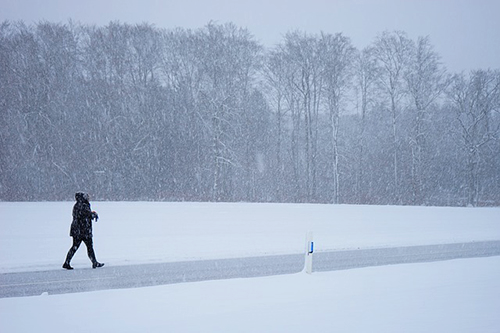Winter Slip and Fall Accidents in Ontario
Every winter, Sokoloff Lawyers deal with claims resulting from slip-and-fall accidents in Toronto and the GTA. In the wrong circumstances, anyone can have an accident on an icy or snowy sidewalk, but there are some steps you can take to help keep you safe. Here are some strategies for protecting yourself and family members from a winter slip-and-fall:
Wear the right boots.
In Canada, proper winter boots are a necessity. Make sure the soles of your boots provide excellent traction, and that they are a good fit. Avoid heels and leather soles. If you can’t afford new boots, add a pair of strap-on rubber crampons, available in many stores. The spikes on these devices give you extra grip on icy terrain.
Keep walkways on your own property cleared.
Since you’re bound to be using your own sidewalks more than any others, it only makes sense to clear these thoroughly. If health problems prevent you from shoveling your walk, hire someone to help. Sprinkling salt on your walkways can help to keep them clear, too.
Adopt a more cautious way of walking.
Although it may not make you look hip, taking small steps and shuffling penguin-style can really cut down on your potential for slipping Spread your weight evenly and be sure that your centre of gravity remains constant. And walk slowly! Taking time is important.
Be extra-cautious on steps or uneven ground.
Most falls occur when you are stepping from one height to another. Take advantage of handrails where they exist, or ask for help if you need it.
Avoid carrying heavy items.
Numerous heavy shopping bags, large boxes, furniture, or other burdens can throw off your centre of gravity and make you far more susceptible to falling.
Keep your eyes open.
Never walk without being able to see clearly. Avoid carrying objects that obstruct your view, walking with fogged-over glasses, or a hood/scarf/toque/balaclava that keeps you from seeing properly.
Hands free.
Don’t put your hands in your pockets. Wear good gloves or mittens to ensure that your hands will be warm; having your hands free helps you to keep your balance.
Wipe your feet.
When you enter a public building, use mats to keep the soles of your boots dry. This will keep your boots safer, and keep floor surfaces from getting slippery. In your own home, remove boots before entering the living area.
Get fit.
A large percentage of slip-and-falls happen to elderly people, but the more fit you are, the less likely you are to fall, and the less likely a fall is to cause severe injury. Exercise often and stay strong!
Watch where you’re going.
This sounds silly, but many accidents happen during a moment of distraction. Don’t be tempted to look at your phone while walking; don’t get so absorbed in thought or conversation that you forget to look at the terrain you’re covering.
Choose the best route.
Plan ahead to take the path that’s most likely to be clearest. If you’re unsure whether any given area is dangerous or not, stop and tap it with your foot to assess it. Avoid slopes and hills whenever you can. And stay out of the street, which can put you in additional danger.
Use a walking stick.
A wooden pole, ski poles, or a dapper walking stick can help you stay upright in the snow. In Norway, using a walking pole is common, and helps to prevent falls.
Bring kitty litter.
If you carry a small bag of clay kitty litter with you, you can sprinkle some on icy spots in order to give you additional traction.
Danger zones.

Some situations present more risk than others. From dusk until mid-morning, visibility is poor, and temperatures drop, so ice reforms. If your mobility is compromised, avoid walking during these times. Getting in and out of a vehicle can also be a risky situation; be sure that you have your footing before letting go of a door or handle. And it should go without saying, but avoid climbing ladders or going up on rooftops. Sever injuries often result when someone falls from a great height.
Learn how to fall.
If you are afraid you may fall, learn the safest way to hit the ground! Experts suggest leaning into the fall and rolling. The goal is to land on a fleshy part of your body rather than landing on your wrists, knees, or spine. If you have a puffy winter coat, that can help to provide a cushion, too.
Even if you take precautions, you may experience a slip-and-fall accident. If you do, remember that it’s important to consult with a personal injury lawyer as soon as possible. In Ontario there are strict deadlines for making a claim against a municipality after a fall. A personal injury lawyer will be able to advise you about your own situation.
Be careful, and walk safe this winter!